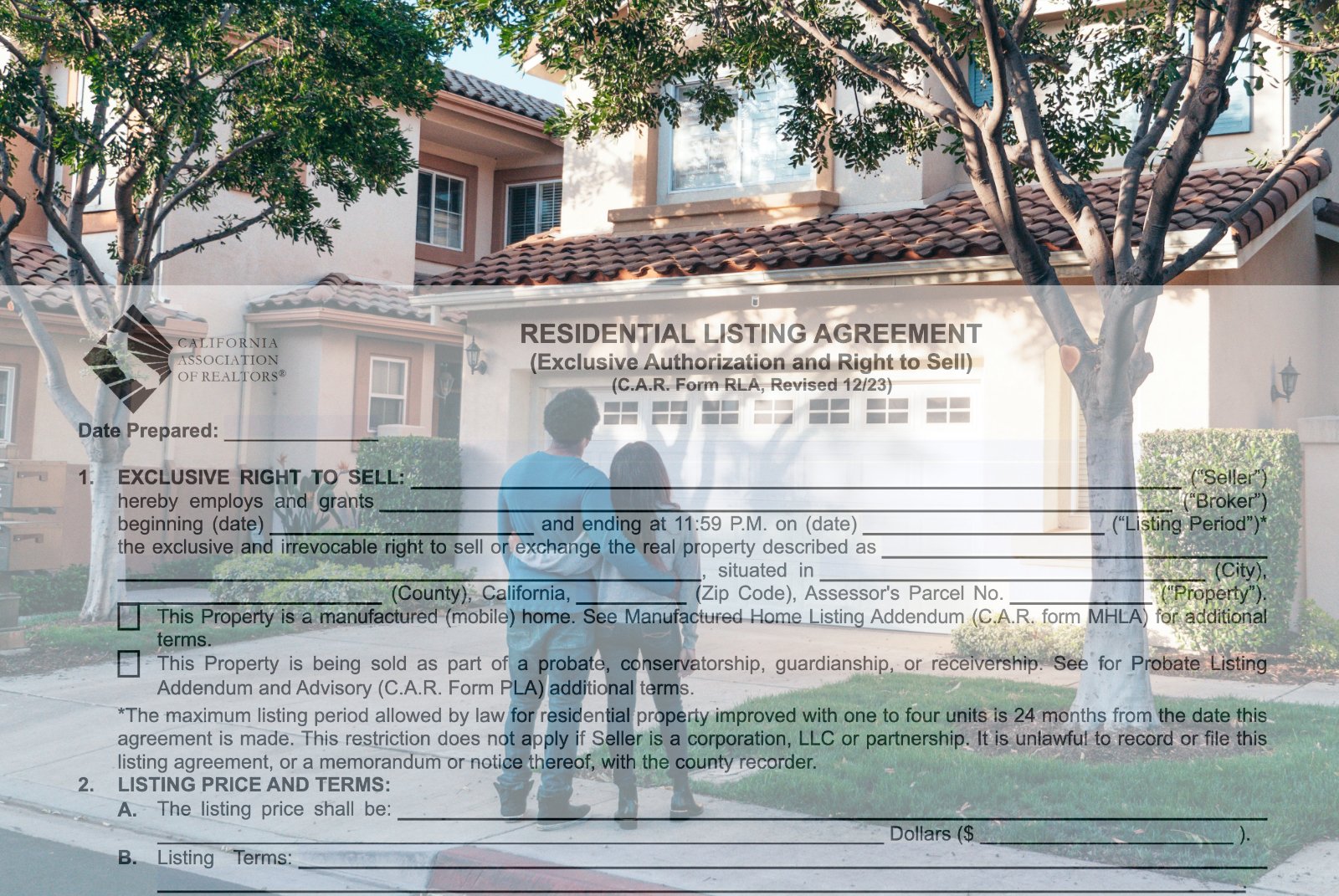The California Association of REALTORS (CAR) Residential Listing Agreement (“RLA”) sets out the terms and conditions used by Bay Area REALTORs for listing most residential homes sold in California. This agreement lays the groundwork for the relationship between the REALTOR® and the homeowner, outlining the responsibilities, rights, and expectations of both parties during the sale of residential property. Understanding this agreement is essential for both agents and sellers to ensure a smooth and legally compliant transaction process.
It should be noted that while there are several types of listing agreements, this article specifically looks at CAR Form RLA – the Exclusive Authorization and Right to Sell listing agreement, which is most commonly used by Bay Area and Silicon Valley REALTORs. This Quick Guide takes you through what I consider to be the most important paragraphs and clauses of this agreement between the listing agent and the homeowner. However, it must be noted that the RLA is a legally binding contract and as such you may want to have it reviewed by your attorney before signing it. This article should in no way be considered legal advice.
Introduction to the Residential Listing Agreement
The California Association of Realtors Residential Listing Agreement represents a foundational element of real estate transactions in California. This document not only formalizes the relationship between a real estate agent and a property seller but also sets forth the terms and conditions under which a property is marketed and sold. For sellers, knowledge of the agreement’s provisions is crucial for a transparent and smooth property selling experience.
Download a draft copy of the California Residential Listing Agreement Revision 12/24 here:
RLA_12-2024_draftv5
Paragraph 1
This identifies the property that is to be sold, the names(s) of the seller and the real estate brokerage, and the beginning and ending dates of the listing agreement.
Paragraph 2, Items A1-2
This is the core set of terms for the listing agreement. It’s a grid full of blanks that will be filled in and a series of checkboxes. Each item on the grid has a corresponding paragraph number that references a later paragraph in the listing agreement. So for example, paragraph 2 Item A(1) is the listing period (the beginning and ending date of the agreement), and it notes that it corresponds with Paragraph 4G of the contract (“MAXIMUM LISTING PERIOD”).
Paragraph 2 Item A(2) is the listing price, which is the price at which the broker is allowed to advertise and market the property for sale. It’s important to understand that by signing a listing agreement you are not obligated to sell your home at list price, or any price. It only authorizes the broker to advertise your property for sale at that price (and only that price), and be paid for that work if – and only if – the sale is successfully closed (and assuming the seller does not default on specific terms of the listing agreement or a purchase agreement).
Paragraph 2, Items C1-4
Paragraph 2 Item C(1) specifies the amount of compensation (commission) that will be paid to the listing broker. Remember: there is no standard commission, and commissions are always negotiable. It is important to note that this commission amount is for the listing broker only. It is possible (actually, quite likely) that the buyer will have an agent, and that the buyer will want the seller to pay the buyer’s agent’s fee, but this is negotiated when a buyer presents an offer.
Item C(2) specifies additional compensation to the listing broker in the event that the buyer does not have any representation (which will usually create much more work, and additional risk, for the listing agent).
Item C(3) specifies a number of days past the expiration of the listing period (specified in paragraph 1) beyond which the seller agrees to pay the broker a commission if and only if, prior to the expiration of the listing period, the broker submits to the seller a list of names of buyers identified during the listing period, and one of those buyers makes an offer which is accepted by the seller and the sale then closes. It is important to note that Paragraph 2 Item C(3) is tied to Paragraph 4D which states that the broker will be owed a commission if, during the listing period and without the consent of Broker the Property:
without Broker’s prior written consent, the Property is withdrawn from sale, conveyed, leased, rented, otherwise transferred, or made unmarketable by a voluntary act of Seller during the Listing Period, or any extension.
Remember that any contract in California requires that all parties to the contract act in good faith. If the seller voluntarily and intentionally does anything that causes the property to become unmarketable that would be construed as a breach of the covenant of fair dealing and would therefore expose the seller to the risk of paying the broker a commission in this event.
Paragraph 2, Items D1-5
Specifies which items that may not be considered “real property” are included or excluded in the sale. Such items typically include major appliances, certain light fixtures, etc. This also declares which items that may appear to “belong to the property” are actually liened or leased items. These items typically include water softeners, propane tanks, and solar panels. Additionally, this paragraph deals with “smart home” features like smart thermostats, lighting, cameras, locks, doorbells, window coverings and the like. Some Bay Area sellers who want to keep this hardware can now exclude it from (or specifically include it in) the sale.
Paragraph 2, Items E1-3
This section names the Multiple Listing Service that the listing will be marketed through. It also deals with the seller’s instructions about mentioning in the “private remarks” of the listing that the seller is open to paying buyer concessions (e.g., covering the cost of the buyer’s agent’s commission). Here, the seller can also instruct the listing broker not to use any photographs in marketing the property.
Paragraph 2, Items F1-3
This paragraph outlines the seller’s and broker’s duties. Chiefly it informs the sellers that the Broker is obligated to present all offers to the seller (unless otherwise instructed in writing). The 12/23 modification to the listing agreement now allows the seller to confirm in writing that no offers are to be presented to the seller for review until a specific date, or until the home has been listed on the MLS for a certain number of days. I personally view this as bad practice and unnecessarily limits the broker’s ability to negotiate on the seller’s behalf.
It also instructs broker not to present “buyer letters” to the seller unless seller specifically instructs broker that they are to be presented. By default the listing agreement states that these are not be be presented as they protect the seller from claims that they are making a violation of fair housing laws.
Paragraph 4
This paragraph explains when and how the broker earns their commission. It states that the broker is entitled to compensation once a ready, willing, and able buyer has been found and escrow is completed—or even if escrow fails to close solely because of the seller’s actions. The paragraph also covers situations where the broker may still receive a commission after the listing period ends, specifically if a buyer who was introduced during the listing period ends up purchasing the property within a defined “Continuation Period.” Additionally, if the seller unlawfully withdraws the property from the market, leases it out, transfers ownership, or otherwise makes it unmarketable without the broker’s approval, the broker is still entitled to be paid. The agreement also gives the broker the right to provide escrow with instructions to pay their commission directly from the seller’s proceeds, even if the sale closes after the listing has expired.
Paragraph 7
This section of the Residential Listing Agreement outlines the mutual responsibilities of the broker and seller in the listing and sale process. The broker is expected to use reasonable effort and diligence to achieve the sale and, unless otherwise directed in writing, is authorized to order necessary reports, advertise the property broadly (including via MLS and online), and disclose the existence and terms of offers to other real estate professionals. Regarding offers, the seller can choose whether all offers are presented as they come in or held until a later date—though this may impact buyer interest and is subject to MLS rules. The agreement also addresses buyer letters (sometimes called “love letters”), advising sellers that such letters may unintentionally reveal protected characteristics, which cannot lawfully be considered when choosing an offer.
Sellers are expected to act in good faith by allowing showings, referring all inquiries to the broker, and determining their listing and sale price. They also agree to timely order and pay for any required reports, especially if the property is part of a homeowners association, where early document collection may help avoid escrow delays. Importantly, sellers must disclose any material facts about the property and are liable for any issues that arise from undisclosed conditions or incorrect information they provide. This includes indemnifying the broker from related disputes or legal actions.
Paragraph 9
This section of the Residential Listing Agreement explains the agency relationship between the broker and the seller. It confirms that the broker will represent the seller in any resulting transaction unless stated otherwise, and that the seller has received required agency disclosure forms. The agreement also addresses the possibility of dual agency, where the broker may represent both the seller and the buyer in the same transaction. The seller consents to this arrangement, provided the broker discloses the dual role early on and maintains confidentiality—especially regarding each party’s financial or negotiating positions. The broker is still required to disclose any known facts that materially affect the property’s value to both parties.
Additionally, the seller agrees that the broker may represent other buyers or sellers who are interested in similar properties, both during and after the listing period. If a buyer refuses representation, the broker may still work with them after obtaining a signed non-agency disclosure. Finally, the agreement states that the broker must confirm the agency relationship in writing when a purchase offer is made, and that the broker’s representation ends when the listing agreement expires or the transaction closes.
Additional Documents in the RLA Package
When your agent sends you a purchase agreement to sign, it will almost invariably contain numerous other documents for you to sign. While the RLA itself is “only” 7 pages, the current page count of the total package is currently 19 pages all together. Here is a run-down of the additional documents in the RLA package:
Disclosure of Agency Relationships
The Disclosure of Agency Relationships is actually the first document in the RLA package, and should be signed first. This form in California is essential for defining the responsibilities and roles of real estate agents in a transaction. This disclosure must be given to buyers or sellers at the outset, even before any other property buying or selling documents are signed, making it the initial document in the RPA package. Its importance lies in its ability to ensure transparency and to aid clients in comprehending the scope and depth of the agent’s fiduciary responsibilities towards them. The signing of this form by all involved parties signifies their recognition and understanding of these agency relationships, thus promoting a more knowledgeable and reliable transaction process.
Multiple Listing Service Addendum
The MLS Addendum aligns with both state and national standards to ensure transparency and fairness in how listings and associated broker compensation are handled. The changes are largely driven by a major settlement requiring MLS systems—whether public-facing or feed-based—to no longer display or support compensation offers to buyer brokers. Specifically, MLS platforms can no longer list compensation amounts for buyer broker services, and they are prohibited from creating any alternative structures to share or filter compensation data. All such references must be removed from MLS fields and systems in order to comply with the new policy .
In addition, the addendum reinforces a strong cooperation requirement, meaning MLS participants must continue to share listing information and make properties available for showing to all other brokers. Brokers are also required to enter written agreements with buyers before showing properties, clarifying the terms of representation and compensation. Furthermore, MLSs are forbidden from filtering or restricting listings based on offered compensation or broker/agency names—ensuring all properties are displayed fairly regardless of commission structure .
Together, these revisions uphold MLS’s core role in promoting broad access to listings while respecting evolving compensation and antitrust laws. By removing commission disclosures and enforcing unbiased display rules, the updated addendum provides a more standardized and legally compliant framework for listing cooperation across California MLS platforms.
Possible Representation of More than One Buyer or Seller – Disclosure and Consent
The Possible Representation of More than One Buyer or Seller – Disclosure and Consent form is a key element in maintaining transparency and ethical standards in California’s real estate transactions. It is employed by real estate agents and brokerages in situations where they represent, or may potentially represent, multiple buyers or sellers interested in or negotiating for the same property. This form is crucial for disclosing any instances of dual or multiple representation to all parties involved, clearly outlining the Broker’s responsibilities and duties in these circumstances.
Broker Compensation Advisory
The Broker Compensation Advisory is a required one-page disclosure that explains how real estate agents get paid and the options available to clients. It clarifies that broker compensation is not set by law, but negotiated individually based on factors like the scope of services, experience, and agreement terms. For sellers, it emphasizes that while listing agreements typically outline the seller’s responsibility to pay their own broker and may allow sharing compensation with a buyer’s broker, there is no legal obligation to do so—those terms are fully negotiable between seller and broker. For buyers, the advisory clarifies that compensation can come from the buyer directly, from the seller (via terms in the purchase agreement or a separate agreement), or from the listing broker, and the advisory encourages clear agreements to prevent misunderstandings.
The form also highlights recent changes: since the NAR settlement, listing brokers can no longer use MLS fields to display or mandate compensation for buyer’s brokers. Instead, each party must separately negotiate and document compensation agreements outside MLS. All clients must acknowledge receiving and understanding this advisory. By requiring this form up front, C.A.R. promotes transparency, encourages informed negotiation, and helps protect against commission-related disputes.
Fair Housing and Discrimination Advisory
The Fair Housing and Discrimination Advisory form acts as both a reminder and a commitment to uphold the principles of the Fair Housing Act and the California Fair Employment and Housing Act. This document clearly specifies the prohibition of discrimination in housing-related activities such as sale, rental, financing, or provision of housing, on the basis of race, color, religion, gender, disability, familial status, national origin, among other protected characteristics. By distributing this advisory, real estate professionals in California ensure that their clients are fully informed of their rights and duties under these laws. The form is instrumental in preventing discriminatory practices and fosters a culture of inclusivity and equal opportunity in the housing sector. This is particularly significant in diverse areas such as the Bay Area and Silicon Valley.
Seller’s Advisory
The Seller’s Advisory is a critical document designed to guide and inform sellers during the real estate transaction process. This comprehensive form serves as an advisory, outlining the various responsibilities, risks, and considerations a seller should be aware of when selling a property. It includes key sections on the importance of accurate disclosures, legal compliance, potential tax implications, and the necessity of understanding the terms of the sale agreement. Additionally, it advises on the roles and limitations of real estate agents, emphasizing that they do not provide legal or tax advice. The Seller Advisory is an essential tool in ensuring sellers are fully informed and prepared for the intricacies of a real estate transaction, aiming to facilitate a smoother, more transparent selling process.
California Consumer Privacy Act Advisory, Disclosure, and Notice
This advisory informs California consumers that they have specific rights under the CCPA, effective January 1, 2020. It explains that personal information—including photographs, property sale details, and other non-public data—may be collected during real estate transactions. The advisory clarifies that some entities, such as real estate brokers and Multiple Listing Services (MLSs), may be “covered businesses”, which must comply with the CCPA’s requirements, while others may be classified as “third parties”, which are not directly regulated under the CCPA .
Under the CCPA, consumers have rights that include:
-
Knowing what personal information is collected, how it is used, and with whom it is shared,
-
Requesting deletion or correction of their information,
-
Opting out of having it sold or shared (especially for sensitive data), and
-
Limiting use of sensitive personal data .
However, these rights are subject to legal obligations that require data retention—brokers and MLSs must keep transaction records for three years regardless of a deletion request . The advisory also notes that not all real estate entities are covered by CCPA, but those that are must maintain a privacy policy, provide “notice at collection,” and fulfill consumer requests regarding their data .
Finally, consumers are advised to exercise their rights by contacting the relevant brokerage or service provider directly. The advisory also points users to the California Department of Justice and the California Privacy Protection Agency for more information on privacy rights and enforcement .
Conclusion
The California Association of REALTORS form RLA is one of the foundational documents of the real estate business in the Bay Area and California as a whole. There are several different listing agreements that are used, however this one is the most common.
It is important to understand that this is an exclusive right to sell – which means that no matter how the property is sold, whether or not there is any direct involvement in consummating the sale by the broker, the broker is entitled to receive the full commission as stipulated in Paragraph 3A(1). It is very important that sellers understand this, and all the other facets and nuances of this crucial real estate contract.
Silicon Valley Luxury Homes for Sale
2
3
4
5
6
7
8
9
10
11
12
13
14
15
16
17
18
19
20
21
22
23
24
25





